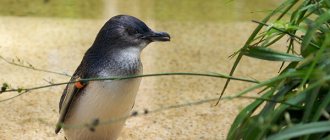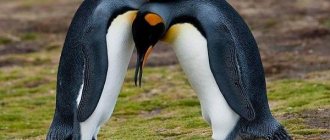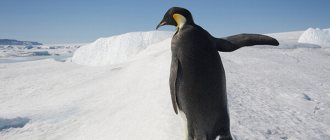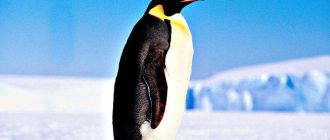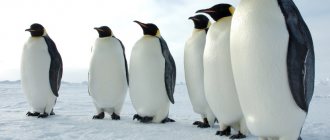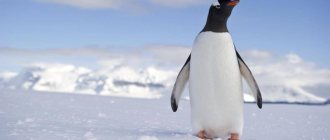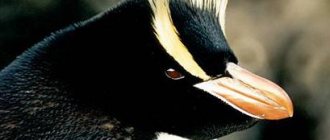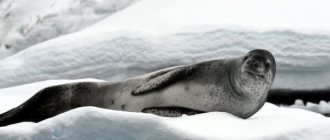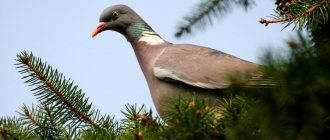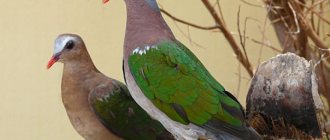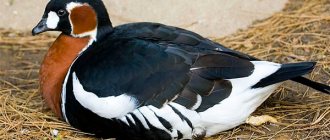- Wild animals
- >>
- Birds
The emperor penguin is the oldest and largest bird of all representatives of this family existing on earth. Translated from ancient Greek, their name means “wingless diver.” Penguins are distinguished by interesting behavior and extraordinary intelligence. These birds tend to spend a lot of time in the water. Unfortunately, the numbers of these majestic birds are constantly declining. Today the number of individuals does not exceed 300,000. The species is under protection.
Origin of the species and description
Photo: Emperor penguin
The emperor penguin is a representative of the class of birds, order Penguinidae, family Penguinidae. They are classified as a separate genus and species, the emperor penguin.
These amazing birds were first discovered in 1820 during Bellingshausen's research expedition. However, the first mentions of emperor penguins appeared in the writings of explorers Vasco da Gama in 1498, who drifted off the African coast, and Magellan, who met the birds in 1521 off the South American coast. However, ancient researchers drew an analogy with geese. The bird was called a penguin only in the 16th century.
Further study of the evolution of these representatives of the class of birds indicates that their ancestors existed in New Zealand, some regions of South America, and the Antarctic Peninsula. Zoological researchers also discovered the remains of the ancient ancestors of emperor penguins in some regions of Australia and Africa.
Video: Emperor Penguin
The oldest remains of penguins come from the end of the Eocene period and indicate that they may have existed on earth approximately 45 million years ago. The ancient ancestors of penguins, judging by the remains found, were much larger than modern individuals. It is believed that the largest ancestor of modern penguins was the Nordenskiöld penguin. His height corresponded to the height of a modern person, and his body weight reached almost 120 kilograms.
Scientists have also found that the ancient ancestors of penguins were not waterfowl. They had developed wings and could fly. Penguins have the greatest number of similar characteristics with tubenoses. Based on this, both species of birds have common ancestors. Many scientists have studied birds, including Robert Scott in 1913. As part of the expedition, he went from Cape Evans to Cape Crozier, where he managed to get several eggs of these amazing birds. This made it possible to study in detail the embryonic development of penguins.
Appearance and features
Photo: Emperor penguin Antarctica
The height of an adult emperor penguin is 100-115 cm, especially large male individuals reach a height of 130-135 cm. The weight of one penguin is 30-45 kilograms. Sexual dimorphism is practically not expressed. Females are slightly smaller than males. As a rule, the height of females does not exceed 115 centimeters. It is this species that is distinguished by developed muscles and a pronounced thoracic region of the body.
The emperor penguin has a bright and interesting color. The outer surface of the body from the back is painted black. The inside of the body is white. The area of the neck and ears is painted bright yellow. This color allows these representatives of flora and fauna to remain unnoticed in the depths of the sea. The body is smooth, even, very streamlined. Thanks to this, birds can dive deeply and quickly develop the desired speed in the water.
Interesting! Birds are able to change color depending on the time of year. The black color will change to brown with the onset of November, and remains so until the end of February.
The hatched chicks are covered with white or light gray plumage. Penguins have a small, round head. It is most often painted black. On the head there is a fairly powerful, long beak and small, black eyes. The neck is very small, merges with the body. A powerful, pronounced chest smoothly flows into the stomach.
On both sides of the body there are modified wings that serve as fins. The lower limbs are three-fingered, have membranes and powerful claws. There is a small tail. A distinctive feature is the structure of bone tissue. They do not have hollow bones like all other bird species. Another distinctive feature is that in the blood vessels of the lower extremities there is a mechanism for regulating heat exchange, which prevents heat loss. Penguins have reliable, very dense plumage, which allows them to feel comfortable even in the harsh climate of Antarctica.
Where does the emperor penguin live?
Photo: Emperor penguin bird
The main region where penguins live is Antarctica. In this region they form colonies of varying sizes - from several tens to several hundred individuals. Particularly large groups of emperor penguins number several thousand individuals. In order to settle on the ice blocks of Antarctica, birds move to the edge of the continent. To breed offspring and hatch eggs, the birds always return in full force to the central regions of Antarctica.
Research by zoologists has established that today there are about 37 bird colonies. As habitats, they tend to choose places that can serve as shelters and protect these representatives of flora and fauna from natural enemies and strong, prickly winds. Therefore, they are most often located behind ice blocks, cliffs, and snow drifts. A prerequisite for the location of numerous bird colonies is free access to the reservoir.
Amazing birds that cannot fly are mainly concentrated between 66 and 77 lines of south latitude. The largest colony lives in the Cape Washington area. Its population exceeds 20,000 individuals.
Islands and regions where emperor penguins live:
- Taylor Glacier;
- Domain of the Fashion Queen;
- Heard Island;
- Coleman Island;
- Victoria Island;
- South Sandwich Islands;
- Tierra del Fuego.
What does the emperor penguin eat?
Photo: Emperor penguin Red Book
Given the harsh climate and eternal frost, all the inhabitants of Antarctica obtain their food in the depths of the sea. Penguins spend about two months a year at sea.
Interesting! This species of birds has no equal among divers. They are able to dive to depths of up to five hundred meters and hold their breath underwater for almost twenty minutes.
The depth of diving directly depends on the degree of illumination of the water depths by sunlight. The more light the water has, the deeper these birds can dive. When in water, they rely only on their vision. During hunting, birds reach speeds of up to 6-7 km/h. The source of food is fish of various species, as well as other marine life: shellfish, squid, oysters, plankton, crustaceans, krill, etc.
Penguins prefer to hunt in groups. Several penguins literally attack a school of fish or other sea creatures and grab everyone who does not have time to escape. Penguins consume small prey directly in the water. Large prey is pulled onto land, and, tearing it into pieces, they eat it.
In search of food, birds are able to cover enormous distances, up to 6-7 hundred kilometers. At the same time, they are not afraid of severe frosts from -45 to -70 degrees and piercing storm winds. Penguins spend a huge amount of effort and energy catching fish and other prey. Sometimes they have to dive up to 300-500 times a day. Birds have a specific structure of the oral cavity. They have spines that are directed backwards, making it easy to hold prey with their help.
Movement in water
Penguins can move in three ways in the water:
- swim underwater;
- jump out of it onto land;
- float on the surface.
When a bird swims on the surface, only the back and head are visible from the body. Penguins are best at swimming underwater. Air resistance helps you jump out of it, since it is less than water resistance.
Features of character and lifestyle
Photo: Emperor penguins in Antarctica
Penguins are not solitary animals; they live in group conditions and create strong pairs that last throughout the life of the birds.
Interesting! Penguins are the only birds in existence that do not know how to build nests.
They lay eggs and hatch offspring, hiding behind natural shelters - rocks, cliffs, ice, etc. Almost two months a year are spent at sea in search of food, the rest of the time is spent incubating eggs and hatching offspring. Birds have a very developed parental instinct. They are considered excellent, very sensitive and caring parents.
Birds can move on land on their hind limbs, or lying on their stomachs, moving their front and hind limbs. They walk slowly, slowly and very awkwardly, since their short lower limbs do not bend at the knee joint. They feel much more confident and agile in the water. They are able to dive deeply and reach speeds of up to 6-10 km/h. Emperor penguins emerge from the water, making amazing leaps up to several meters long.
These birds are considered very cautious and timid. Sensing the slightest approach of danger, they rush in all directions, leaving eggs and their offspring behind. However, many colonies are very welcoming and friendly towards people. Often they are not only not afraid of people, but also look at them with interest, and even allow them to touch themselves. Complete matriarchy reigns in bird colonies. Females are leaders; they choose their own males and seek their attention. After a pair has formed, the males incubate the eggs, and the females go hunting.
Emperor penguins are very resistant to severe frosts and strong winds. They have quite developed subcutaneous fatty tissue, as well as very thick and dense plumage. To keep warm, the birds form a large circle. Inside this circle the temperature reaches +30 at an ambient temperature of -25-30 degrees. In the center of the circle there are often cubs. Adults change places, moving from the center closer to the edge, and vice versa.
Interesting facts about the animal
- Emperor penguins gather in tight groups to stay warm in the harsh conditions of the South Pole. In such a pile the temperature can reach 35 degrees above zero. So that each individual can warm up, the birds change places.
- The creature was first discovered at the beginning of the 19th century.
- The bird moves on land at a speed of 1 to 2 kilometers per hour. The distance covered can reach 100 kilometers.
- This is the most faithful bird of all living on earth.
- While swimming, the emperor penguin can jump to a height of up to 3 meters.
- The chick is born from an egg that is stored between the upper limbs and belly of the female.
- The creature's lifespan is a quarter of a century. Moreover, the individual survives and reproduces normally in captivity.
- Born birds weigh very little, but are very voracious. At one time, a baby can eat up to 6 kg of food.
- They live in colonies of several thousand birds. However, the partner will never confuse his female among other clones and recognizes her by her voice.+
Still have questions or have something to add? Then write to us about it in the comments, this will make the material more useful, complete and accurate.
Social structure and reproduction
Photo: Emperor penguin chick
Penguins tend to form strong, long-lasting pairs. A pair is formed on the initiative of the female. She chooses her own companion, leaving no chance for other, less successful males. Then the female begins to very beautifully care for the male. First, she lowers her head, spreads her wings and begins to sing songs. The male sings along with her in unison. In the process of mating chants, they recognize each other by voice, but do not try to sing louder than others, so as not to interrupt the singing of others. Such courtship lasts almost a whole month. The pair moves one after another, or performs peculiar dances with beaks thrown back upward. The entry into marriage is preceded by a series of mutual bows.
At the end of April or in May, the female lays one egg. Its weight is 430-460 grams. Before laying an egg, she does not eat anything for a month. Therefore, after the mission is completed, she immediately goes to sea for food. She stays there for about two months. During this entire period, the future father looks after the egg. He places the egg in a fold of skin between the lower limbs, which acts as a pouch. No amount of wind or frost will force the male to leave the egg. Males without families pose a threat to future fathers. In a fit of rage, they can take the egg away or break it. Due to the fact that fathers treat their offspring so reverently and responsibly, more than 90% of eggs
Males lose significant weight during this period. At this moment, their weight does not exceed 25 kilograms. The female returns when the male experiences an unbearable feeling of hunger and calls her back. She returns with supplies of seafood for the baby. Next is daddy’s turn to rest. His rest lasts approximately 3-4 weeks.
For the first two months, the chick is covered in down and is unable to survive in the harsh climate of Antarctica. He exists only in the warm, cozy pocket of his parents. There the temperature is constantly maintained at least 35 degrees. If, by a fatal accident, the cub falls out of the pocket, instant death awaits it. Only with the arrival of summer do they begin to move independently and learn to swim and get their own food.
Natural enemies of emperor penguins
Photo: Great Emperor Penguin
In their natural habitat, birds do not have many enemies in the animal world. They risk becoming prey to leopard seals or predatory killer whales when they go out to the open sea in search of food.
Other feathered predators - skuas or giant petrels - pose a greater threat to defenseless chicks. They pose no danger to adults, but are a serious threat to chicks. According to statistics, approximately a third of all chicks die due to attacks by birds of prey. Most often, solitary cubs become the prey of feathered predators. To protect their offspring from attack, birds form so-called “nurseries,” or clusters of babies. This increases their chances of survival.
Humans pose a serious threat to the species. Back in the 18th century, sailors began to exterminate birds whose nests were located in the coastal zone. Due to poaching, by the beginning of the 20th century, these amazing birds were on the verge of extinction.
Places of distribution
Birds live in Antarctica. These birds come further south than other species.
Birds live in colonies. The largest of them include up to 10 thousand individuals.
In 2009, scientists studied satellite images of the mainland and noticed 38 areas with penguin droppings. The discovery means that 38 colonies live on the territory of eternal ice. Initially, scientists claimed the existence of 34 colonies.
Birds are always located in places with shelters:
- ice floe
- cliff.
But the main condition is access to the open ocean.
About 300 thousand individuals live on the ice around Antarctica. But during the mating season, they move inland, hatch eggs and raise offspring. Birds return only after feeding the young and a period of molting.
In 2006, Russia issued a postage stamp depicting emperor penguins.
Population and species status
Photo: Female emperor penguin
A significant threat to the emperor penguin population is climate change and warming. Rising temperatures lead to the melting of glaciers, that is, the destruction of the natural habitat of birds. Such processes lead to a decrease in the birth rate of birds. Due to climate change, certain species of fish, shellfish, and crustaceans are becoming extinct, which means the food supply of penguins is decreasing.
Humans and their activities play a large role in the disappearance of emperor penguins. People exterminate not only penguins, but also catch fish and other inhabitants of the deep sea in large quantities. Over time, the number of species of marine life is constantly decreasing.
Recently, extreme tourism has become very common. Lovers of new sensations go to the most inaccessible and uninhabited places on the globe. Antarctica is no exception. In this regard, the habitat regions of emperor penguins are becoming clogged.
Lifestyle
Surprisingly, it is a fact that matriarchy reigns in the emperor penguin society. In animals, both sexes have completely reversed roles. The female herself looks for a partner and cares for the male she likes. Later, that is, when the egg appears, the male incubates it, and the female becomes the breadwinner. This distribution of responsibilities in animals is very rare.
Animals do not even create packs, but entire colonies. Despite such a love for communicating with their own kind, during the nesting period the couple leaves the colony and returns with a newborn.
